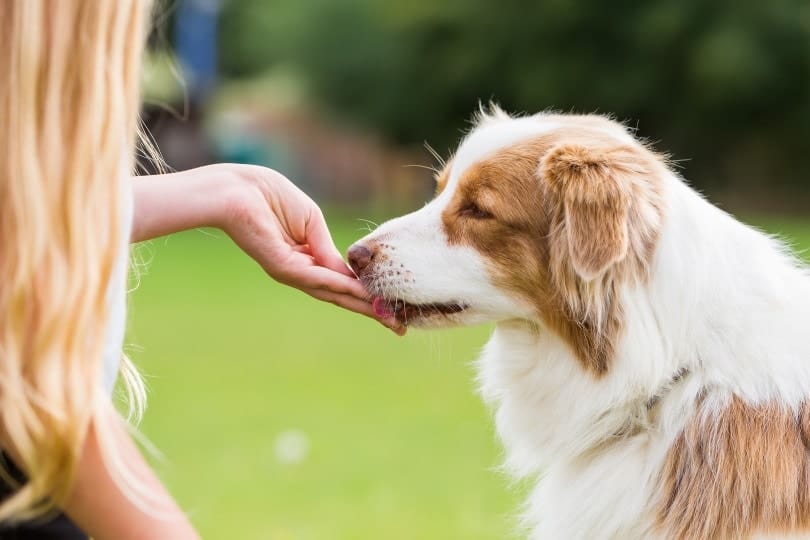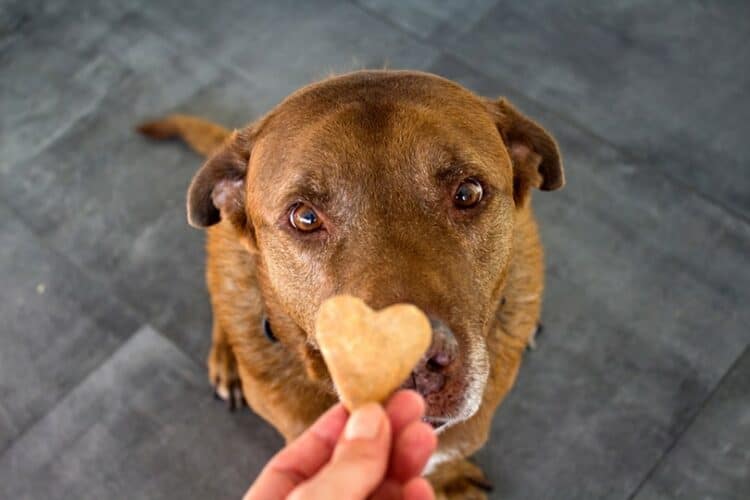It’s okay to offer your dog a treat every day, so long as you don’t overdo it. And that’s where many pet owners get confused. How do you know how many treats are too many?
Dogs come in many different breeds and sizes, and other dogs go through hard-core training. So, you can’t fall back on a solid number. The best way to determine how many treats per day for your dog is okay is through calorie counting. Ideally, treats should make up for 10% of your dog’s daily diet.
Don’t worry, figuring this out isn’t hard. Today, we’re showing you exactly how to do it and giving you some low-fat treat ideas for your pooch. Let’s get started!
The 10% Rule
You can’t know what 10% of your dog’s daily caloric intake is if you’ve never measured it before, so that’s where we’re starting.
Dog food bags have done much of the work for you. All you have to do is look at the bag for the “kcal/cup” measurement. It should read somewhere near the nutrition label on the side or back of the bag.
Once you find the number, continue with the following steps:
- Record how many kcal/cup is in your dog’s food.
- Record how many cups of food per day your dog eats.
- Multiply the amount of food and calories.
4 cups of kibble x 325 calories = 1,300 calories per day
Pretty easy! But before you reach for that treat bag, you need to know if you’re feeding the right amount of calories.
The best way to figure this out is by taking your dog to the vet and having your dog examined. The doctor can give you an optimal weight goal and how many calories to feed your dog based on your dog’s current health.
Suppose you can’t go to the vet. In that case, try this calorie calculator to see how many calories your dog should consume daily. It will also tell you how many treat calories your dog should have.
Once you know how many calories your dog should consume, multiply the number by 10%.
1,300 calories x .10 = 130 treat calories
And there’s your number! Keep in mind that this number is a part of your dog’s daily caloric intake. So, if you overfeed on treats, you’ll want to offer less kibble. Just make sure your dog doesn’t spoil its dinner.

Low-Calorie Treat Options
A low-fat treat option is a good idea if you tend to go overboard on treats. That way, your dog enjoys the treat but doesn’t gain so much weight. Here are a few low-fat dog treat ideas so you don’t have to worry about calorie overload.
Fruits and Vegetables
Fruits and vegetables are an excellent substitute for regular, fatty dog treats (as long as you don’t feed anything toxic). The best fruits and vegetables to occasionally offer your dog include:
- Cucumber
- Carrot Sticks
- Green beans
- Apple slices (without the seed or core)
- Blueberries
Fresh Chicken
If your dog isn’t allergic to chicken, try offering some fresh poultry. You can get creative and provide other chicken parts, like the liver. It’s wise to cook it, so you don’t make your dog sick.
- Chicken Breast
- Chicken liver
- Chicken gizzard
- Chicken feet
Dog Treats
The above treats require some preparation. But if you don’t have time, a store-bought low-fat option is best. Our favorites are listed below.
Will Too Many Treats Kill My Dog?
Sometimes, we go over the limit with treats. Even humans have an extra potato chip every now and then. But does it kill you? Nope! Well, at least not in the short term.
Your biggest concern with offering too many treats is obesity which can lead to other health problems, like diabetes.
So, in a sense, too many treats can harm your dog. But going over the limit for one day won’t put your dog in the hospital. Just be mindful of how many treats you’re feeding and practice moderation.
Conclusion
Pairing the occasional treat with a balanced diet and daily exercise will keep your dog happy and healthy. It’s okay to give your dog a treat every day as long as you don’t go overboard.
Figure out how many calories you’re feeding, then figure how many calories your dog should be getting. From there, you can have an accurate number to shoot for.
Featured Image Credit: Shutterstock














